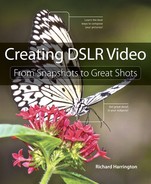Introduction
I truly love the power of video. It’s my favorite medium for telling stories because it gives me the ability to capture life and emotion. For more than 25 years, I’ve been shooting video, capturing family moments on the weekend and creating television commercials, broadcast news, and web video on the weekdays.
However, the best feeling is not seeing my own work, but rather watching others catch enthusiasm and decide to become visual storytellers. Two years ago I set out to document the merger of photography and video when I co-wrote From Still to Motion: A photographer’s guide to creating video with your DSLR for Peachpit Press. The book was well received by the pro community, but I heard from many that they needed a foundation to build on. I also talked to friends, relatives, and even perfect strangers who wanted to learn how to shoot great video on a tight budget (without having to rope their friends into being part of the crew).
To this end, I present Creating DSLR Video: From Snapshots to Great Shots. I set out to teach people how to make better video and short films using minimal gear and resources. The goal is to make the most of what you have and focus on building the core skills you need to succeed. Whether you’re just getting started with video or you’re an enthusiastic still shooter who’s been at it for years, I’ll guide you through how video works and help you get the best shots.
The book begins by illustrating what’s so great about shooting DSLR video. You’ll understand why you’d choose to shoot video on a “stills” camera as well as some of the problems to look out for. Chapter 2 then walks you through equipment choices. Whether you’ve bought a new camera or just want to get more from your existing gear, I’ll explain how here. I also focus on what new gear is most useful as you grow into your hobby and start to invest.
In Chapter 3 you’ll learn how to set up your camera properly. You’ll learn important technical steps, like how to white balance for natural color, which frame rate to shoot at, and which settings produce smooth motion. Chapter 4 explains how to properly expose your shots and maintain critical focus.
The important skills needed for composition are covered in depth in Chapter 5. You’ll learn the language of cinematography and how to think about linking multiple shots into a narrative sequence.
The next three chapters tackle several common shooting scenarios. Chapter 6 provides you with strategies for outdoor shooting and working with the sun. In Chapter 7 you’ll explore the opposite problem of shooting when there is very little light. You’ll then learn how to control the light when shooting indoors and how to add more light in Chapter 8.
A good video is incomplete without a stellar sound track. In Chapter 9 you’ll learn how to record better audio with your camera. You’ll also learn about essential equipment and workflows if you want to record the best sound possible.
The last three chapters describe what happens after you shoot. In Chapter 10 you’ll learn how to organize and back up your footage so it’s ready to edit. Chapter 11 walks you through the essentials involved in editing video. You’ll still want to pick up some dedicated training for whatever nonlinear editing software you choose, but this chapter will help you understand the creative choices you’ll need to make. The final chapter explores how to publish your video so others can see it. You’ll learn how to target popular websites to share online and how to export a backup copy.
Now, just turn the page to begin your journey to become a better videographer.

